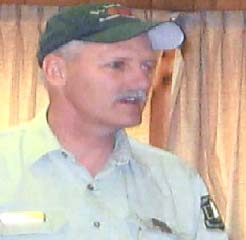
District Ranger Calls Meeting October 2nd on Salvage Opportunities
NOTICE OF PUBLIC MEETING — POST FIRE TIMBER SALVAGE
Location: Happy Camp Grange Hall
Date/Time: October 2, 2007 at 6:30 PM.
By Alan Vandiver, District Ranger

Alan Vandiver
Happy Camp District Ranger
The recent fires in the Happy Camp Ranger District were generally of moderate and low intensity. In most areas, overstory mortality was scattered or confined to small groups of trees. However, on about 15% of the burn area, fire was intense enough to kill larger groups of mature trees.
Just after September 1st, I began to gather preliminary data on these areas. This initial effort will be complete by the end of the month. On October second, my staff and I would like to present this information to you and hear your thoughts on how this timber should be used. We are particularly interested in your thoughts on harvest, retention for ecosystem function and burned area harvest effects such as yarding systems, soil and watershed effects.
I would also like to use this notice to provide a brief update about ongoing rehabilitation and repair efforts associated with the fire.
Roads: Where draws were intensely burned above roads, there is a higher risk that debris will wash down hill to plug culverts. This would, in turn, wash out roads and deliver sediment into streams. We have mapped these high risk areas and are developing a plan to patrol/clean these culverts during the upcoming rainy season. It looks like funding will be available to do this.
Although I closed roads for safety reasons during the fires, I began opening roads as safety concerns diminished. All roads that were open prior to the fires have been reopened.
Fireline: I was, and continue to be, very concerned about repair of the dozer line built during the fires. All indirect dozer line has now been water barred and covered with slash to reduce watershed, soils, fisheries and wildlife impacts. Crews and equipment continue working on perimeter and interior dozer lines.
Silviculture: As smoke cleared and dust settled, District personnel began to evaluate mortality in harvested stands. This effort began with a helicopter flight on August 28. District personnel mapped concentrations of mortality in large trees and in plantations. Unfortunately, more than 1000 acres will need to be replanted. Plantations at the heads of draws which aligned with the wind during the fire suffered complete mortality in many cases. Since the first part of September, we have been building on this initial aerial mapping to plan reforestation efforts for next year.
I look forward to visiting with you on October 2nd and to hearing your thoughts and concerns regarding post fire management.